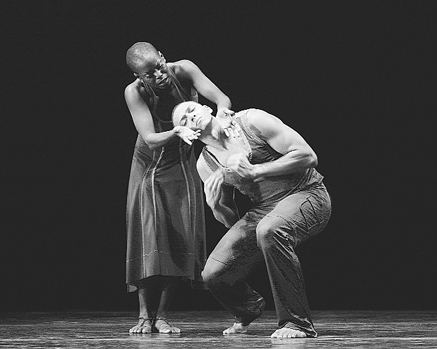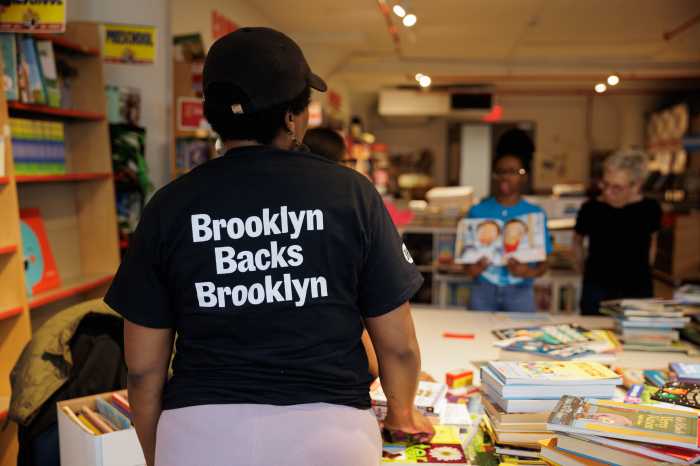Great American troupe gives the people what they want
“Acceptance in Surrender” is the high-voltage choreographic debut of three Ailey dancers who put their heads together this season in response to director Judith Jamison’s call. Hope Boykin, Abdur-Rahim Jackson, and Mathew Rushing, made believers of us all. Wendy White Sasser grounded the work Sunday evening, December 18 with her solid performance of the central struggling figure.
In an original twist, three angels present themselves first and they are men in blue unitards. Jamar Roberts, Vernard J. Gilmore, and Amos J. Machanic, Jr. are centerstage in an Ailey-style formation, opening the evening with a bang to an original score by Philip Hamilton. One moves in spurts, as if he is lit by strobes. But Al Crawford’s excellent lighting can’t be credited there. Every movement of White-Wasser’s is deliberate and clear, even the pointing and flexing of her toes seems remarkable. She spins on her stomach on the floor, her body bowed. She struggles terribly, her limbs beseech, and with her arms out to the side she seems to say, “Why me?” In the end, she’s lifted by the angels, creating a crucifix image with those arms, in a powerful release.
Next, “Solo,” a company premiere by the Dutch Hans van Manen. Clifton Brown, Glenn Allen Sims, and Rushing challenge in a series of light-hearted, fast-moving solos with touches of humor in costumes by Keso Dekker—gray tights and purple jerseys with bright cadmium underneath. Rushing looks superhuman as they follow each other in the limelight with crisp multiple turns and signs like the self-hug or ‘what up’ gesture. To Johann Sebastian Bach’s speedy Violin Suite no.1 in D Minor, the virtuosity of these three is no laughing matter.
The prayerful “Witness” is an Ailey choreography from ‘86. “Oooooooh” is the involuntary response when the curtain opens on rows of glowing candles. It’s performed beautifully by Dwana Adiaha Smallwood in a long white dress by Kirsten Lund Nielson that creates a feeling of flight with the dancer’s extended limbs, while in a recorded spiritual Jesse Norman sings “My soul is a witness for my Lord.”
“Urban Folk Dance” was made in 1990 by Ulysses Dove, who died in ‘96 after living with AIDS. It was restaged by Masazumi Chaya, and performed by the young and extraordinary Roberts with an excellent Aisha Thomas, and Sims with Tina Monica Williams. The two couples dance at tables in two scenes that make way for each other so that there’s no conflict about where to look. In the duets about relationships, the same feeling is achieved with different sequences. Thomas and Roberts’ incredible moves rival Sims and Williams’ deeper expression.
Though “Reminiscin’” unabashedly looks back on earlier days, to a selection of popular music from the ‘70s or mid-century, it speaks in a contemporary voice. It is just a joyous festival of dancin.’ Edward Hoppers “Nighthawks” was an inspiration but choreographer Judith Jamison peoples the lonely village diner with fun-loving uptown club-goers. “Reminiscin’” affirms this scene’s contribution to dance and to well-being. In her male love duet between Brown and Kirven J. Boyd, Jamison embraces love itself and love of dance.
A grisaille cityscape in a set of windows is projected on the cyclorama, designed by Michael Fagin. The gritty dramatic scene is high above the dance floor and counter where 11 linger dressed for fun and dancing. It’s not just fun, as we see in a melting duet of Boykin and Brown to the chilling “A Case of You” recorded by Diana Krall. With considerable grace Boykin “still be standing on her feet” (from the Joni Mitchell lyrics)—as she watches Brown dance. Renee Robinson leads the women with her yellow basket to “A Tisket A Tasket” by Ella Fitzgerald. Never coy or trite, Robinson instigates the infectious fun. Linda Celeste Sims does a smokin’ solo to a jazzy number; Brown is “Reminiscin’s” dazzling star.
gaycitynews.com



































